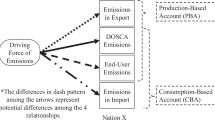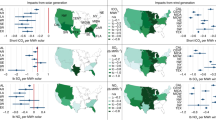Abstract
Two of the most widely emphasized contenders for carbon emissions reduction in the electricity sector are nuclear power and renewable energy. While scenarios regularly question the potential impacts of adoption of various technology mixes in the future, it is less clear which technology has been associated with greater historical emission reductions. Here, we use multiple regression analyses on global datasets of national carbon emissions and renewable and nuclear electricity production across 123 countries over 25 years to examine systematically patterns in how countries variously using nuclear power and renewables contrastingly show higher or lower carbon emissions. We find that larger-scale national nuclear attachments do not tend to associate with significantly lower carbon emissions while renewables do. We also find a negative association between the scales of national nuclear and renewables attachments. This suggests nuclear and renewables attachments tend to crowd each other out.
This is a preview of subscription content, access via your institution
Access options
Access Nature and 54 other Nature Portfolio journals
Get Nature+, our best-value online-access subscription
$29.99 / 30 days
cancel any time
Subscribe to this journal
Receive 12 digital issues and online access to articles
$119.00 per year
only $9.92 per issue
Buy this article
- Purchase on SpringerLink
- Instant access to full article PDF
Prices may be subject to local taxes which are calculated during checkout



Similar content being viewed by others
Data availability
All data generated or analysed during this study are included in this published article and its Supplementary Information.
References
Pacala, S. & Socolow, R. Stabilization wedges: solving the climate problem for the next 50 years with current technologies. Science 305, 968–972 (2004).
Armstrong, R. C. et al. The frontiers of energy. Nat. Energy 1, 15020 (2016).
Morgan, M. G., Abdulla, A., Ford, M. J. & Rath, M. US nuclear power: the vanishing low-carbon wedge. Proc. Natl Acad. Sci. USA 115, 7184–7189 (2018).
Chu, S. & Majumdar, A. Opportunities and challenges for a sustainable energy future. Nature 488, 294–303 (2012).
Stephen, J. D. et al. Net-zero emissions energy systems. Science 360, eaas9793 (2018).
Jin, T. & Kim, J. What is better for mitigating carbon emissions—renewable energy or nuclear energy? A panel data analysis. Renew. Sustain. Energy Rev. 91, 464–471 (2018).
Vaidyanathan, G. Nuclear power must make a comeback for climate’s sake: James Hansen and other climate scientists argue for more reactors to cut coal consumption. Scientific American https://www.scientificamerican.com/article/nuclear-power-must-make-a-comeback-for-climate-s-sake/ (4 December 2015).
Cao, J. et al. China-U.S. cooperation to advance nuclear power. Science 353, 547–548 (2016).
Kharecha, P. A. & Hansen, J. E. Prevented mortality and greenhouse gas emissions from historical and projected nuclear power. Environ. Sci. Technol. 20, 4889–4895 (2013).
International Energy Agency Energy Technology Perspectives 2012 (OECD, 2012).
Climate Change and Nuclear Power (International Atomic Energy Agency, 2013).
Kharecha, P. A. & Hansen, J. E. Prevented mortality and greenhouse gas emissions from historical and projected nuclear power. Environ. Sci. Technol. 47, 4889–4895 (2013).
International Energy Agency Technology Roadmap: Nuclear Energy (OECD, 2010).
Jacobson, M. Z. et al. 100% clean and renewable wind, water, and sunlight all-sector energy roadmaps for 139 countries of the world. Joule 1, 108–121 (2017).
Dmitrii, B. et al. Radical transformation pathway towards sustainable electricity via evolutionary steps. Nat. Commun. 10, 1077 (2019).
Mitchell, C. The Political Economy of Sustainable Energy (Palgrave MacMillan, 2010).
Mitchell, C. Momentum is increasing towards a flexible electricity system based on renewables. Nat. Energy 1, 15030 (2016).
Gross, R. et al. The Costs and Impacts of Intermittency: an Assessment of the Evidence on the Costs and Impacts of Intermittent Generation on the British Electricty Network (UK Energy Research Centre, 2006).
Service, R. F. Solar plus batteries is now cheaper than fossil power. Science 365, 108 (2019).
Scrase, I. & MacKerron, G. (eds) Energy for the Future: A New Agenda (Palgrave Macmillan, 2009).
Elliott, D. (ed.) Nuclear or Not? Does Nuclear Power Have a Place in a Sustainable Future (Palgrave MacMillan, 2007).
Johnstone, P. & Stirling, A. Comparing nuclear trajectories in Germany and the UK: from regimes to democracies in social technical transitions and discontinuities. Energy Res. Soc. Sci. 59, 1–27 (2020).
Rutsky, R. L. High Techne: Art and Technology from the Machine Aesthetic to the Posthuman (Univ. of Minnesota Press, 1999).
Gilbert, A., Sovacool, B. K., Johnstone, P. & Stirling, A. Cost overruns and financial risk in the construction of nuclear power reactors: a critical appraisal. Energy Pol. 102, 644–649 (2017).
Wheatley, S., Sovacool, B. K. & Sornette, D. Of disasters and dragon kings: a statistical analysis of nuclear power incidents & accidents. Risk Anal. 37, 99–115 (2017).
Wheatley, S., Sovacool, B. K. & Sornette, D. Reassessing the safety of nuclear power. Energy Res. Soc. Sci. 15, 96–100 (2016).
Barron, R. W. & Hill, M. C. A wedge or a weight? Critically examining nuclear power’s viability as a low carbon energy source from an intergenerational perspective. Energy Res. Soc. Sci. 50, 7–17 (2019).
IRENA Renewable Cost Database and Auctions Database (International Renewable Energy Agency, 2017).
Kobos, P. H., Erickson, J. D. & Drennen, T. E. Technological learning and renewable energy costs: implications for US renewable energy policy. Energy Pol. 34, 1645–1658 (2006).
Nemet, G. F. Beyond the learning curve: factors influencing cost reductions in photovoltaics. Energy Pol. 34, 3218–3232 (2006).
Grubler, A. The costs of the French nuclear scale-up: a case of negative learning by doing. Energy Pol. 38, 5174–5188 (2010).
Hultman, N. E., Koomey, J. G. & Kammen, D. M. What history can teach us about the future costs of U.S. nuclear power. Environ. Sci. Technol. 41, 2087–2094 (2007).
Cohen, B. L. in The Nuclear Energy Option Ch. 9 (Plenum Press, 1990).
Downer, J. & Ramana, M. V. Empires built on sand: on the fundamental implausibility of reactor safety assessments and the implications for nuclear regulation. Regul. Gov. (in the press).
Verbruggen, A., Laes, E. & Lemmens, S. Assessment of the actual sustainability of nuclear fission power. Renew. Sustain. Energy Rev. 32, 16–28 (2014).
Schneider, M. et. al. The World Nuclear Industry Status Report 2019 (World Nuclear Industry Status Report, 2019).
Markard, J., Bento, N., Kittner, N. & Nuñez-Jimenez, A. Destined for decline? Examining nuclear energy from a technological innovation systems perspective. Energy Res. Soc. Sci. 67, 101512 (2020).
Edwards, M. W., Schweitzer, R. D., Shakespeare-Finch, J., Byrne, A. & Gordon-King, K. Living with nuclear energy: a systematic review of the psychological consequences of nuclear power. Energy Res. Soc. Sci. 47, 1–15 (2019).
Bromet, E. J. Emotional consequences of nuclear power plant disasters. Health Phys. 106, 206–210 (2014).
Lehtonen, M., Kojo, M., Jartti, T., Litmanen, T. & Kari, M. The roles of the state and social licence to operate? Lessons from nuclear waste management in Finland, France, and Sweden. Energy Res. Soc. Sci. 61, 101353 (2020).
Petrova, M. A. NIMBYism revisited: public acceptance of wind energy in the United States. Wiley Interdiscip. Rev. Clim. Change 4, 575–601 (2013).
McGowan, F. & Sauter, R. Public Opinion on Energy Research: a Desk Study for the Research Councils (Sussex Energy Group, Science Policy Research Unit, Univ. of Sussex, 2005).
Poortinga, W., Pidgeon, N., & Lorenzioni, I. Public Perceptions of Nuclear Power, Climate Change and Energy Options in Britan: Summary of Findings of a Survey Conducted during October and November 2005 (School of Environmental Science, Univ. of East Anglia, 2006).
Stirling, A. Multicriteria diversity analysis: a novel heuristic framework for appraising energy portfolios. Energy Pol. 38, 1622–1634 (2010).
Stirling, A. Diversity and ignorance in electricity supply investment: addressing the solution rather than the problem. Energy Pol. 22, 195–216 (1994).
World Bank Metadata Glossary; https://databank.worldbank.org/metadataglossary/ida-results-measurement-system/series/EN.ATM.CO2E.PC
Sovacool, B. K., Nugent, D. & Gilbert, A. An international comparative assessment of construction cost overruns for electricity infrastructure. Energy Res. Soc. Sci. 3, 152–160 (2014).
Author information
Authors and Affiliations
Contributions
B.K.S. and A.S.: conceptualization; investigation; methodology; project administration; supervision; validation; writing, reviewing and editing of manuscript. P.S. and G.W.: conceptualization; data curation; formal analysis; methodology; validation; visualization; writing, reviewing and editing of manuscript. G.M.: writing, reviewing and editing of manuscript.
Corresponding author
Ethics declarations
Competing interests
The authors declare no competing interests.
Additional information
Publisher’s note Springer Nature remains neutral with regard to jurisdictional claims in published maps and institutional affiliations.
Supplementary information
Supplementary Information
Supplementary Tables 1 and 2.
Rights and permissions
About this article
Cite this article
Sovacool, B.K., Schmid, P., Stirling, A. et al. Differences in carbon emissions reduction between countries pursuing renewable electricity versus nuclear power. Nat Energy 5, 928–935 (2020). https://doi.org/10.1038/s41560-020-00696-3
Received:
Accepted:
Published:
Issue Date:
DOI: https://doi.org/10.1038/s41560-020-00696-3



